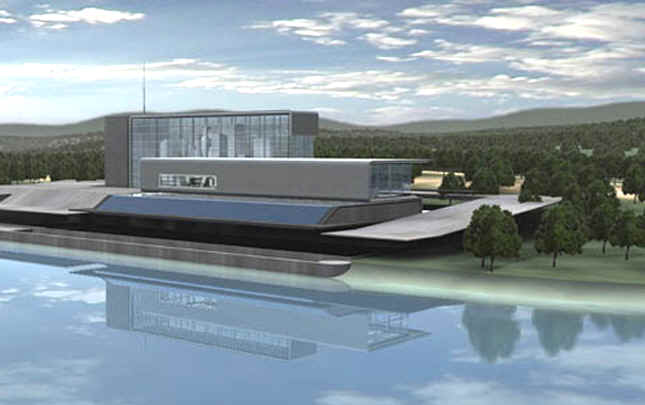![]()
Pollution-Free
Power of the Future
By: Bill Reid
Managing Editor
Secretary of Energy, Spencer Abraham has announced plans for the U.S. to build a prototype of the fossil fuel power plant of the future, a $1 billion venture that will combine electricity and hydrogen production with a virtual total elimination of harmful emissions, including greenhouse gases.
The $1 billion ten-year technological effort is called FutureGen and will be a cost sharing program of government and industry that will be open to both domestic and international participants.

Artist’s rendition of $1 billion Pollution-Free Power Plant of the Future
“FutureGen will be one of the boldest steps our nation has taken toward a pollution-free energy future,” said Secretary Abraham. “Knowledge from FutureGen will help turn coal from an environmentally challenging resource into an environmentally benign one. The prototype power plant will serve as the test bed for demonstrating the best technologies the world has to offer.”
Some of the goals for FutureGen are:
• Electric power production in 2020 at no more than 10% above today’s costs.
• Hydrogen production at 30% less than the cost of today’s gasoline on a Btu equivalent basis.
• Membrane and other technology for carbon dioxide separation.
• Development of multiple forms of deep geologic sequestration salin aquifers, basalt formations, depleted oil and gas reservoirs, unmineable coal seams, and so on.
• Standardizing the technology and methods for carbon dioxide measuring, monitoring, and verification.
The Energy Department is asking the power industry to organize a consortium to manage the project and provide at least 20% of the costs. Virtually every aspect of the prototype plant will be based on cutting edge technology. Although current plans call for the plant to be designed and built over the next five years, then operated for at least five years beyond that, the Energy Department envisions the project serving as a test bed for new technologies well into the coming decade and beyond.
The industrial consortium will design a plant that will turn coal into hydrogen rich gas, rather than burning it directly. The hydrogen could then be combusted in a turbine or used in a fuel cell to produce clean electricity or it could be fed to a refinery to help upgrade petroleum products. In the future the plant could become a model hydrogen production facility for President Bush’s initiative to develop a new fleet of hydrogen powered cars and trucks.
Common air pollutants such as sulfur dioxide and nitrogen oxides would be cleaned from the coal gases and converted to useable byproducts such as fertilizers and soil enhancers. Mercury pollutants would also be removed. Carbon dioxide would be captured and sequestered in deep underground geological formations.
Carbon sequestration will be one of the primary features that will set the prototype plant apart from other electric power projects. Engineers will design into the plant advanced capabilities to capture the carbon dioxide in a form that can be sequestered. No other plant in the world has been built with this capability. The initial goal will be to capture at least 90% of the plant’s carbon dioxide but with advanced technologies, it may be possible to achieve nearly 100% capture.
Once captured, the carbon dioxide will be injected deep underground, perhaps into the brackish reservoirs that lie thousands of feet below the surface of much of the U.S., or potentially into oil or gas reservoirs, or into unmineable coal seams or basalt formations. Once entrapped in these formations, the greenhouse gas would be permanently isolated from the atmosphere.
The plant would be sized to generate approximately 275 megawatts of electricity. Roughly equivalent to an average mid-size coal-fired power plant.
DOE says the prototype plant would be a stepping stone toward a future coal fired power plant that not only would be emission free but would operate at unprecedented fuel efficiencies. Technologies that could be future candidates for testing at the prototype plant could push electric power generating efficiencies to 60% or more, nearly double the efficiencies of today’s conventional coal burning plants.
Coal is the workhorse of the United States’ electric power sector, supplying more than half the electricity the nation consumes. It is also the most abundant fossil fuel in the United States with supplies projected to last 250 years or more. The ultimate goal for the prototype plant, the Energy Department said, is to show how new technology can eliminate environmental concerns over the future use of coal and allow the nation to tap the full potential of its massive coal deposits.
International Participants
According to under Secretary of State for Global Affairs, Paula Dobriansky, a ministerial-level activity called Carbon Sequestration Leadership Forum will be the means through which governments and private entities of other nations participate in FutureGen. The purposes of the forum will be to standardize data gathering, exchange information, and encourage joint project development.
More than a dozen nations are being invited to participate including Australia, Brazil, Canada, China, India, South Africa, the United Kingdom, and the European Union. Likely participants are nations with significant coal reserves and nations with no or few sources of domestic energy.
Such an organization is necessary because fossil energy is too large a part of the global economy and too cost effective to be eliminated from the world’s energy mix, said Dobriansky. The forum’s first meeting will be June 23-25 of this year and it will focus on technologies for dealing with carbon dioxide. Thereafter it will meet twice a year.
cl
This
article is protected by United States copyright and other intellectual property
laws. The article may not be reproduced, rewritten, distributed, redisseminated,
transmitted, displayed, published or broadcast, directly or indirectly, in any
medium without the prior permission of Coal Leader, Inc. Copyright 2003, Coal
Leader, Inc. All rights reserved.